Revised in 2023 with an updated list of bars, and consolidated the specs into a single comparison chart.
Intro
This guide is for women’s olympic weightlifting bars (often referred to in shorthand as oly bars or WL bars) that are best for doing the clean and the snatch.
With the rise of women doing olympic lifting in Crossfit, and other female lifters incorporating olympic lifts into their existing routines, and just more women lifting barbells in general, more and more women are in search of bars that are more appropriate for them than the traditional power bars in most traditional gyms. Men’s WL bars also aren’t the best, because the shafts are thicker than optimal for women’s hands.
Olympic weightlifting bars are used frequently at olympic lifting gyms, Crossfit boxes, the Olympic Games or anywhere that lifters may be doing olympic lifts. They are made to be springy at high loads to facilitate explosiveness, prevent a high shock load for the lifter, and absorb the shock of being dropped.
It isn’t necessary to get a $500-1000 bar just to have a good tool for olympic lifts. Bars in that range are typically IWF certified bars, which carries a huge bump in the price tag reflecting the cost of IWF certification. Plus, those bars are normally not appropriate for anything but practicing a few heavy singles, because the knurling is meant to really grab onto your palms to help you get the barbell up for that one heavy lift that really counts. For learning the lifts and doing regular workouts, you’re better off with a medium knurling that won’t eat up your hands.
Comparison Chart
Scroll right to see all 5 bars.
What to Look For
Weightlifting bars typically have a number of attributes that separate it from women’s all-purpose bars you might encounter.
More Flexible Steel
A good flex facilitates the “whip” desired for pulling heavy cleans off the floor. It makes for a smoother lift off the floor, the way the bar begins to bend upward, ever so slightly, until you pull hard enough that it completely lifts up. This is not noticeable until you get over 300 lbs or so and have done cleans on a WL bar and power bar to feel the difference. With heavier and heavier weights, the difference is huge. A power bar gets really hard to do cleans with.
The second factor in the flex is catching the bar on your shoulders in a clean. With good form the impact on your shoulders is minimal. You can test this yourself at very light weights. Load a couple 25s on, do a messy power clean by catching the bar hard on your shoulders, and it will shake, relieving the impact. Do this with a stiff 30mm power bar and you can see what I’m talking about right away. Which do you prefer? Yep, now you can never go back.
The third point at which the flex helps is bouncing out of the hole as you catch in a full squat clean. The bar tips flex down with you and whip back up as you push yourself out of the hole. Powerlifters specifically do not want this flex, because their squats are slower and any whip will be too fast for them and throw them off. They need a slow, controlled squat that may take a few seconds to complete.
High Tensile Strength Steel
Nowadays it isn’t hard to find tensile strengths over 200,000 PSI (pounds per square inch). In years past that was considered extreme and quite rare.
That isn’t to say that you have to get over 200,000 PSI. Bars well under that should not bend either. Moderately priced bars are all made to hold up to frequent drops with bumper plates onto rubber flooring or a platform. That’s quite a shock load, but it’s not nearly as bad as dropping a bar on the safety pins of a rack, which is likely to bend any bar (or the safety pins – something has to give).
When we talk about bending, we’re talking about a permanent bend, effectively rendering the bar useless or at least extremely annoying to use. Flex under load is normal and is part of what saves the bar from developing a permanent bend. Along with high tensile strength, that’s what keeps the shaft going strong.
The steel formulations today are better for high tensile strength bars for olympic weightlifting, basically so that you can get a high tensile strength bar that isn’t super stiff because of it.
Snap Rings or Roll Pins to Secure the Sleeves
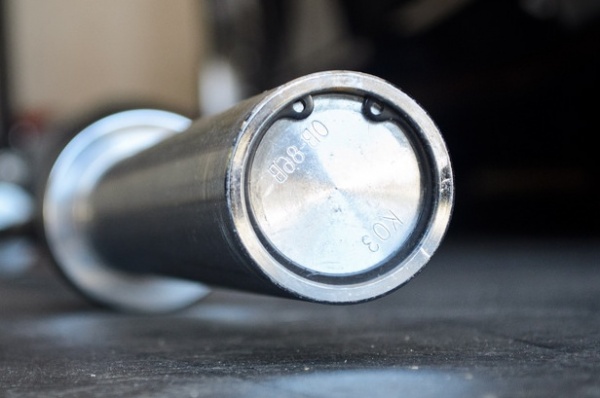
A well-made women’s olympic bar has the end sleeves secured with either a snap ring (also called a retaining ring) or a pin hammered through a hole going the width of the sleeve, which is the method York Barbell in particular prefers. Most everyone besides York does the snap ring method.
One of these methods is to ensure the sleeves don’t break loose and fall off the bar after enough drops with bumper plates. Dropping a bar is tough on it, even on 3/4″ rubber flooring. Good bars can hold up fine. On the cheapest bars, usually sold for around $100 or included in a 300 lb weight set, you’ll find an allen bolt, which you need an allen key (hex key) to tighten. And tighten it you will. These are notorious for coming loose over time. Even if you apply Loctite to it, it will probably just break on you.
Medium to Soft Knurling
The knurling is the texture that cut into the shaft of the bar to help you grip it better.
See our article on knurl types for complete info. Basically a volcano knurl gives you stickiness and less risk of damage to your palms, due to the large number of points on the knurl that don’t go too deep. A hill knurl is good for sliding in your hands better during the grip transition. A mountain knurl is too aggressive here.
No Center Knurling for High Rep Workouts
All bars have knurling over most of the length of the shaft. Some men’s bars have a section of about six to nine inches of knurling in the center of the bar, while others are smooth in that area.
Women’s IWF competition rated bars are required to not have center knurling, as opposed to the men’s standard that has the center knurl required as throwback to the old one-handed snatch that nobody does anymore.
While lifters doing other movements might like the center knurling, for the olympic lifts it serves no purpose anymore but to scratch the front of your neck during cleans. For this reason, lifters concentrating on olympic lifts prefer no center knurling.
The knurling further down the bar should extend to the end of the shaft to accommodate tall users with the maximum width snatch grip, but this isn’t the case on all bars.
910mm Spaced Ring Marks
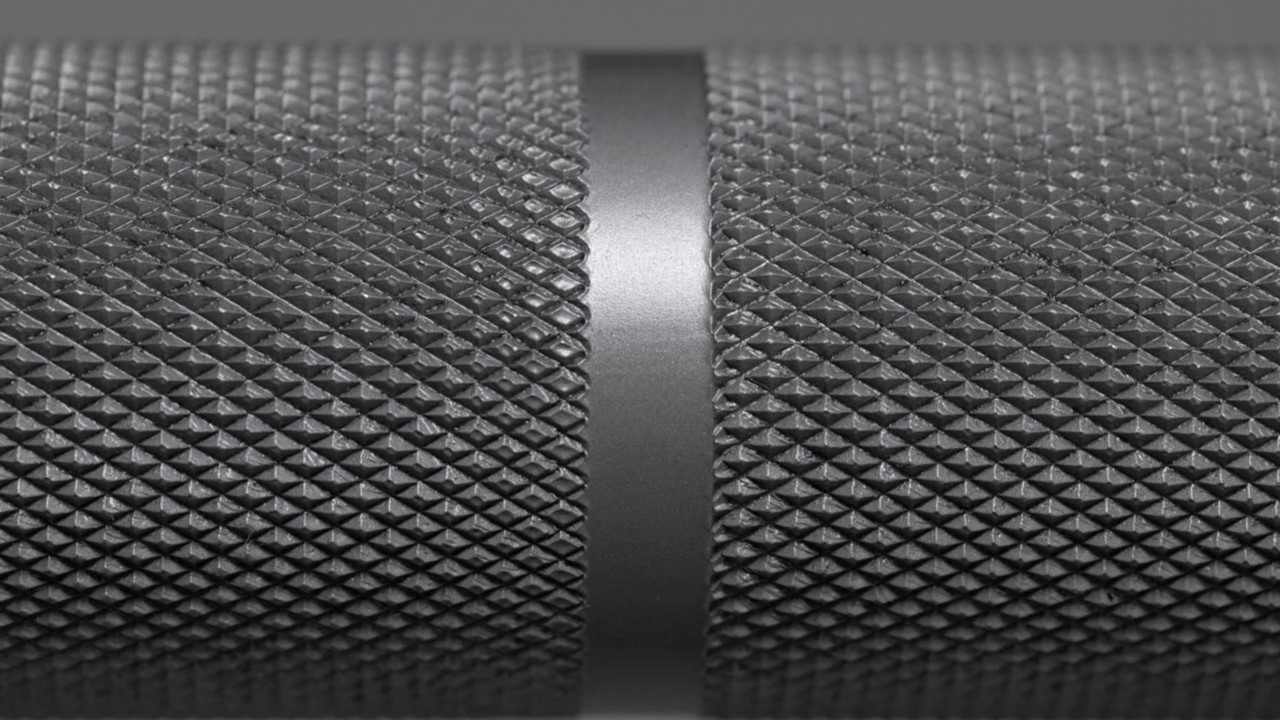
Every bar has a 1/4″ wide smooth mark in the knurling where you place your hands. IWF spaced markings are spaced for olympic weightlifting and are 910mm apart. Lifters grip in various spots depending on their body size, but the knurl marks at least provide a reference point to help them guide their hands into the right spot for them.
In recent years, many manufacturers have added IPF 810mm spaced marks as well, for a pair of “dual” marks 5cm away from each other. They just help you position your hands consistently. That’s all there is to it.
25mm Shaft Diameter
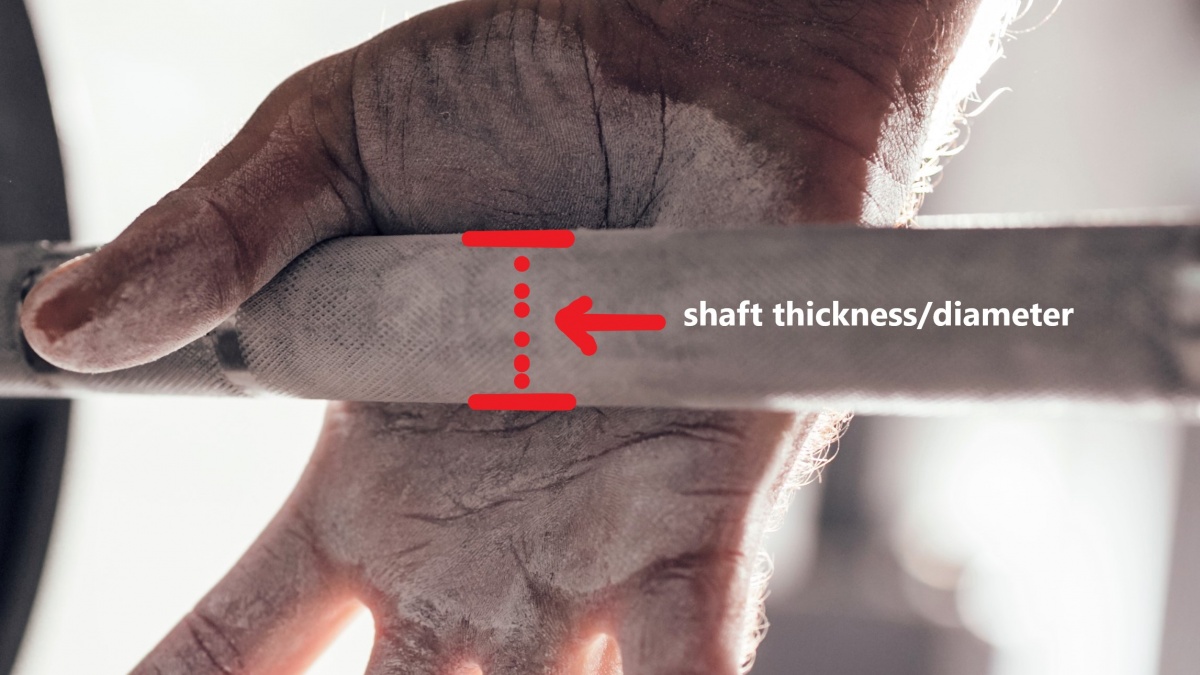
Not to be confused with the size of the sleeve where the weights go, which is always 49.8mm-50.0mm (1.97″) on a high quality bar.
Here we’re talking about the shaft that you grip. For the optimal grip, 25mm is the best size for women’s olympic barbells. It makes for a good pulling grip for most women.
This diameter difference is for one purpose only: to allow a hook grip for those of you who have smaller hands, as is usually the case with women versus men.
– Breaking Muscle
The diameter is also a factor in the amount of flex that the shaft has, which is very important for cleans. See the info further above on flex.
Sensitive and Smooth Rotation
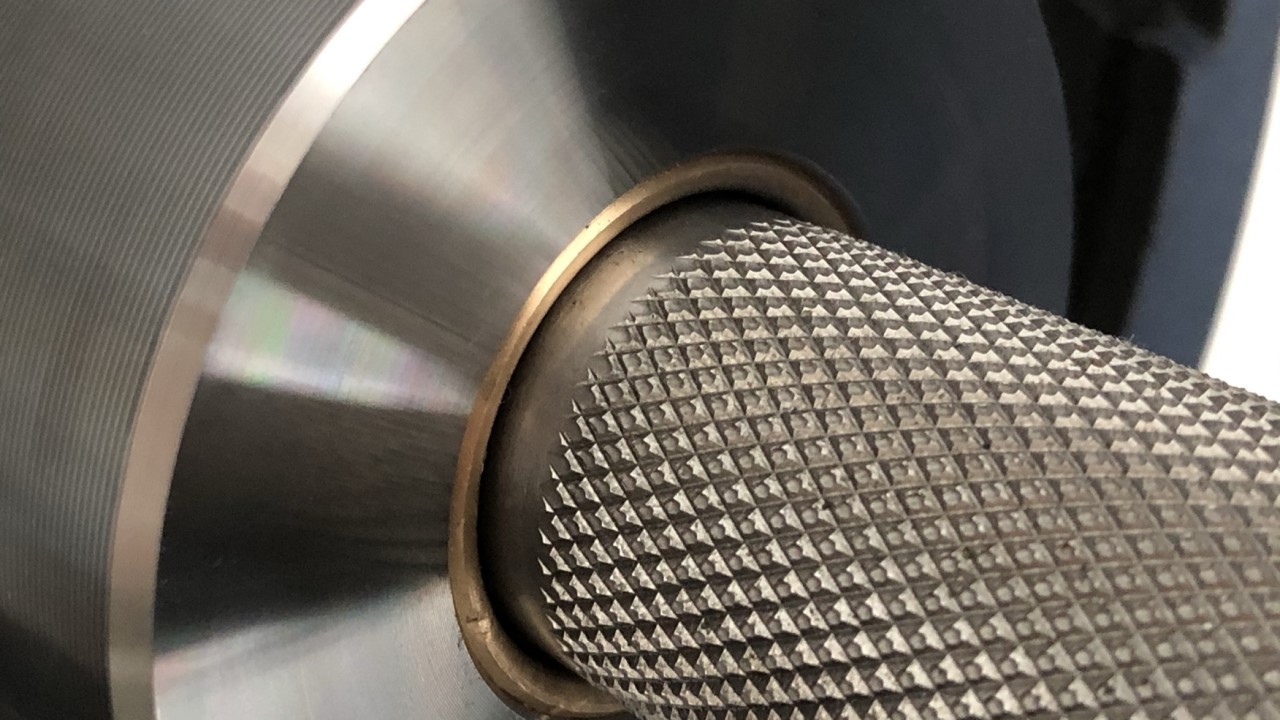
How sensitively and easily the sleeves spin is very important for olympic lifts so you can transition between the pull and the catch without tweaking your wrists.
Manufacturers like Werksan have settled on 5 needle bearings per sleeve for their very best competition bars.
For budget weight lifting bars you don’t need that many. Fewer bearings will reduce the spin, as will a combination of bushings and bearings, but it’s still good.
Bronze bushings are the next step down. Some women’s weight lifting bars we feature below have bronze bushings. Lubricated bronze slides well against steel (I think it has something to do with the dissimilar materials, such that bronze actually slides against steel better than steel-on-steel does).
Shaft Finish
The finish, or outer coating, applied to a bar makes a difference in its durability, tackiness, rust resistance, and how well it holds chalk.
Chrome
Chrome plating looks nice and wears well from repeated banging on a rack. It is also the most resistant to corrosion among all bar finishes, with the exception of stainless steel. The disadvantage of chrome is it is more slippery when wet from sweaty hands.
Black Oxide
This is a thin coating that feels almost like bare steel. It’s thin enough that it doesn’t fill in any of the depth of the knurling like chrome or zinc plating does. It also gives a better grip than chrome. And it helps prevent rust (anti-corrosion), but the anti-corrosion properties of black oxide are activated by oil, so you have to oil it once in a while. It scratches more easily than other finishes, so a bar used in a rack will immediately show signs of use from the metal-on-metal contact. It can also wear off simply from the abrasion of your hands against it over time.
Black Zinc
Like black oxide, it provides a good grip and prevents corrosion without the need to oil it as much. Zinc plating has a certain thickness to it, so it does fill in the knurling slightly like chrome does, making the knurling a softer feel. Zinc itself is a bright silverish color and the black coating is actually applied over the bright zinc.
Weight
Women’s olympic weightlifting bars are made to weigh 15kg / 33lb. There are 35lb women’s bars out there, but here we focus on the 15kg ones. There are more and more women doing barbell work, but at this point a 35lb women’s bar is still a specialty item and not justifiable by most manufacturer’s in addition to a 15kg bar.
The Bars
These four best women’s barbells are in the relatively affordable price range of $200-400 and are suitable for beginner and intermediate lifters who don’t need a competition level bar.
Rogue 25mm Women’s Training Bar
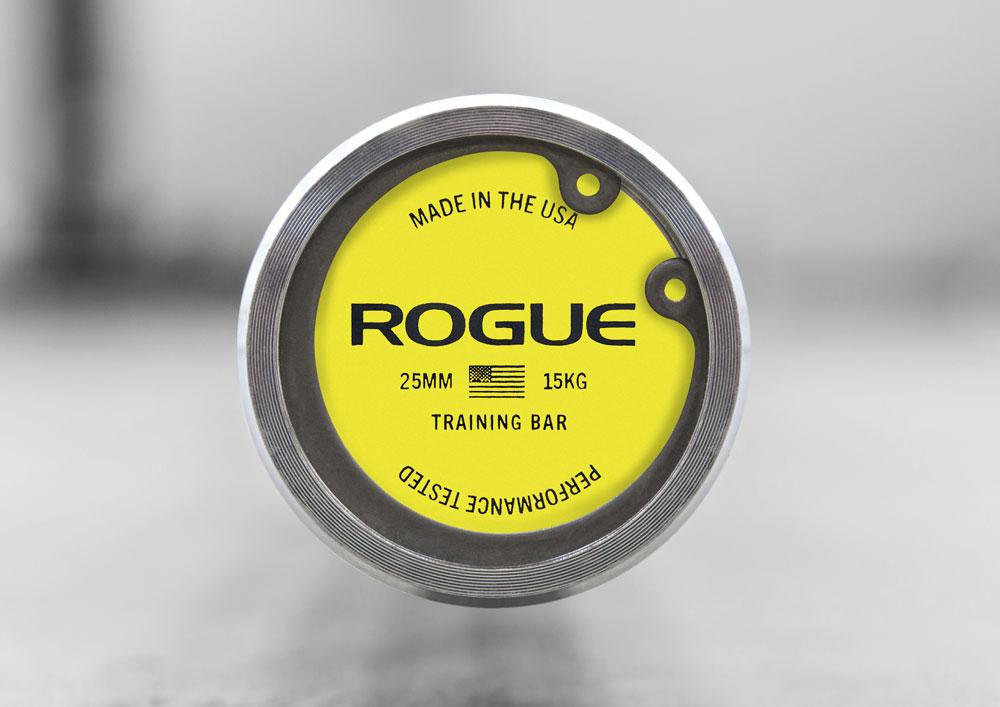
Rogue’s 25mm Training Bar uses the same 190,000 PSI steel shaft as all their other men’s 7ft bars. That makes production a little easier!
While not nearly as popular as their Bella Bar (see our review), which is one of the most widely used barbells for women, this one is more appropriate as a WL specific bar.
Rogue stands behind their products, and you know they’ll be around for years to come. It’s one reason people often go for Rogue when in doubt.
Plus, Rogue makes their bars in their own facility in Columbus, OH. That makes it the only one on this page made in the USA.
With the bushings instead of bearings, this is questionable as a pure WL bar. Bronze bushings are only one step down from needle bearings, better than composite bushings as far as the sensitivity of the spin, if it’s constructed nice and tightly and lubricated right. If you’ve used a good bronze bushing bar and you’re ok with it as a WL bar, this could be a really good choice for you.
Wright Next Gen 15kg Women’s Bar
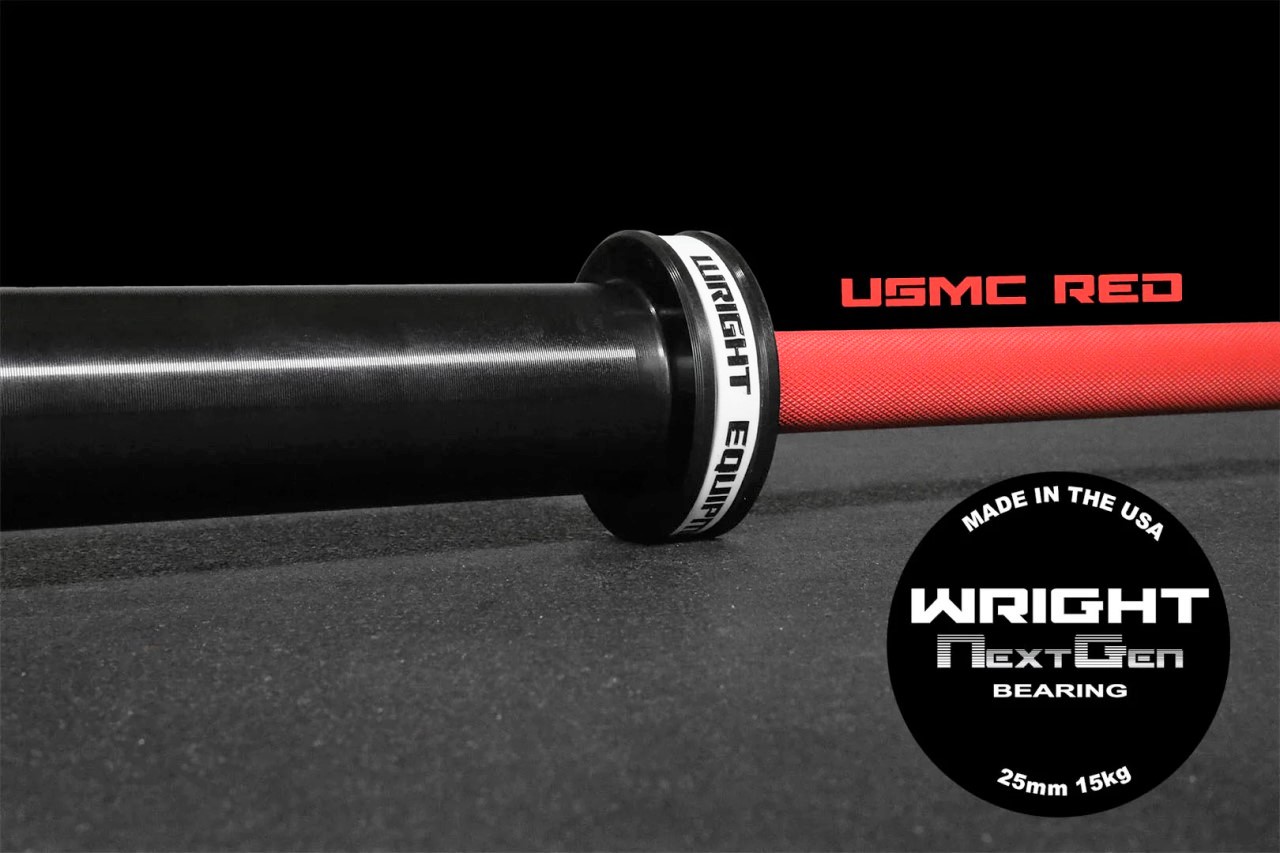
The best priced USA-made bar here, and the only bar here offered in a Cerakote finish, with several color options. The sleeves are zinc plated.
Wright says this bar can be fairly easily disassembled for cleaning, and they encourage you to do so, to keep the bearings in optimal shape. You’ll just need a pair of snap ring pliers. If the sleeve internals get rusty from a humid environment, you can buy their rebuild kit with all new bearings, washers, grease, snap rings, and pliers.
Bells of Steel Women’s Bar 2.0
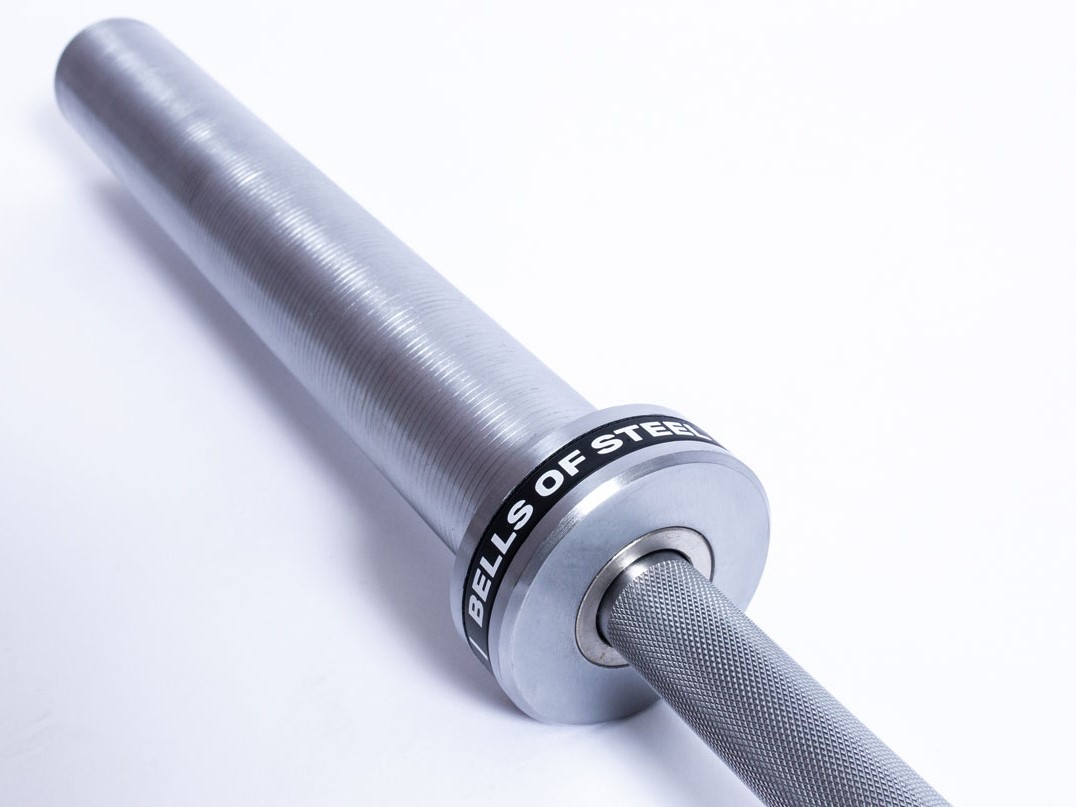
Impressively low price for a needle bearing bar with such a high tensile strength. BoS has good price points for some products like this. Version 2.0 has better steel for the shaft and bearings.
The possible downsides is it’s made in China, and the knurl is more passive than other bars.
The founder of BoS started the company in 2010 selling push sleds and kettlebells in Canada, and over the years they added a large selection of heavy-duty equipment and expanded to a US location in 2018. I’ve bought plates from them. Good experience.
York 32003 Women’s Elite Training Bar
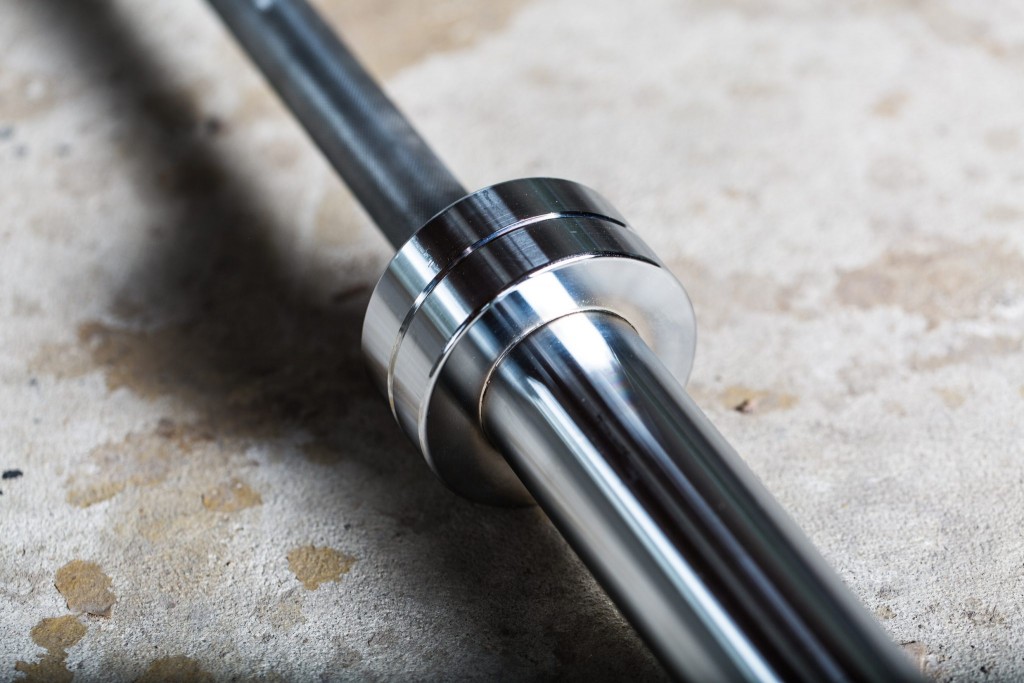
The second-best women’s barbell that York makes! The top one is priced over $500.
Not quite USA made. It’s made in Canada using US steel, like all their Elite series bars.
York Barbell has been involved in olympic weightlifting since their inception in 1932. They revised their bars a year or so back without changing the model numbers. For this one they added dual ring marks and new end caps.
This is the only bar featured here that uses stainless steel bushings in the sleeves, and as such it won’t have as good a rotation as the others.
From the close-up shot you see York’s patented split-sleeve design. Dead giveaway it’s a York bar when you see that.
Rep Fitness Women’s Gladiator Bar
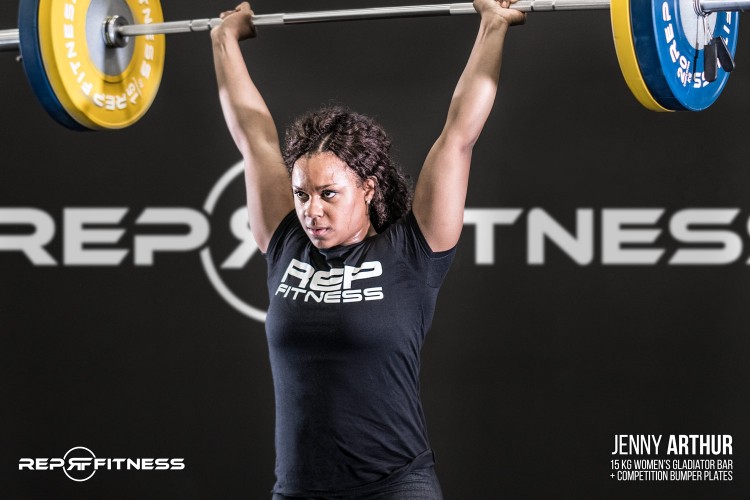
Rep Fitness does not make their women’s version of the Gladiator bar with a stainless steel option. That’s ok, it’s still a great chrome plated bar!
Plus, 5 needle bearings per sleeve… That’s 1 more than Fringe (below).
Rep Fitness has been in business in Denver, Colorado since 2012, and they have earned the respect of the Crossfit crowd with their high quality equipment.
Rep has always had favorable reviews online and are good with answering questions. Rep’s equipment seems to be nearly as high quality as Rogue, although it’s made in China.
In 2021 Rep switched to a free shipping pricing model to simplify things for shoppers, as many other companies have done. Correspondingly they raised the prices of most products to absorb the shipping ost.
FringeSport Women’s Weightlifting Bar
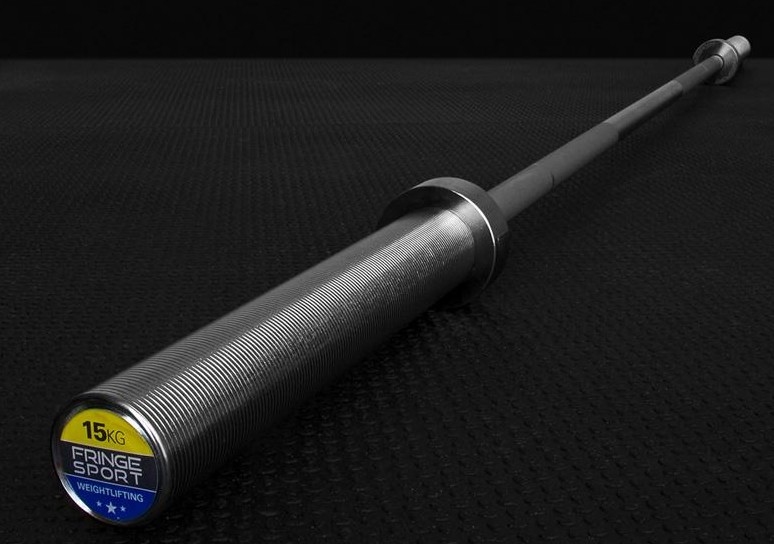
This is Fringe’s flagship olympic weightlifting bar. All their other bars are made for either powerlifting dual-use. This one is their only bar with 4 needle bearings per sleeve, IWF-only ring marks, and it has the most whip out of all their bars despite the high 216,000 PSI tensile strength.
As far as the “matte” chrome… I don’t think that there is any difference between matte chrome and satin chrome, which is what York calls it. The word “matte” has gotten to be a popular buzzword with Rogue and others, with their popular matte finishes on power racks, etc, and the “Matte Black Friday” annual sale. Basically a less glossy chrome that looks more like stainless steel. As if it weren’t already hard to tell the difference!
Fringe’s guarantee is the best. It’s more than just a warranty against defects. They offer a full 1-year guarantee. Return it for any reason within a year and get your money back. Or within 30 days they’ll even pay the return shipping.
The obvious point: This is the highest-priced bar on this list, by far. But if you can catch it on sale, it’s a good pick.

